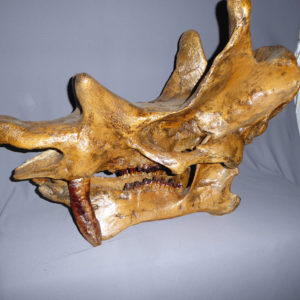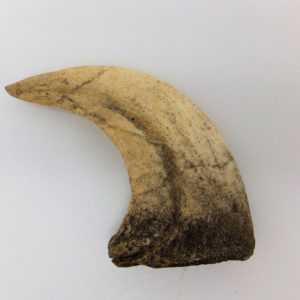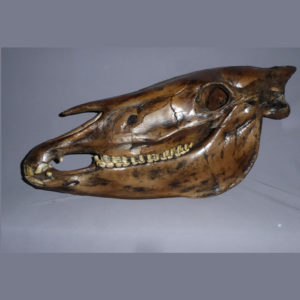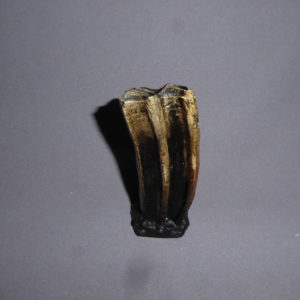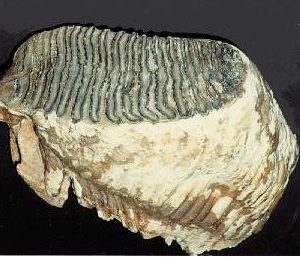All items sold on this website are polyurethane resin replicas, made in USA. No real or natural bone is available on this site.
-
Tyrannosaurus-Rex Harley Skull Replica
$9,900.00The skull bones were massive and the nasals and some other bones were fused, preventing movement between them; but many contained a “honeycomb” of tiny air spaces and thus lighter.
-
Tyrannosaurus-Rex Toe Claw Replica
$30.00Paleontologists originally thought that T. rex had three claws, but later determined that it only had two. Tyrannosaurus Rex used their crescent shaped talons or claws to slash prey at…
-
Uintatherium Mounted Skeleton Replica
$34,000.00Uintatherium (“Beast of the Uinta Mountains”) is an extinct genus of herbivorous dinoceratan mammal that lived during the Eocene epoch.
-
Uintatherium Skull Replica
$1,580.00It’s skull was flat and concave which is rare and not characteristic of any other known mammal. Uintamastix cranial cavity was exceptionally small due the walls of the cranium being…
-
Uintatherium Unmounted Skeleton Replica
$24,000.00Uintatherium (“Beast of the Uinta Mountains”) is an extinct genus of herbivorous dinoceratan mammal that lived during the Eocene epoch.
-
Ultrasaurus Dorsal Vertebra
$4,345.00Ultrasaurus lived 100 to 110 million years ago, during the Aptian and Albian stages of the early Cretaceous. It is known from the holotype DGBU-1973, which consists of part of…
-
Utahraptor Dinosaur Claw Fossil
$16.00Utahraptor’s had a large retractable sickle claw on its foot, specialized for cutting. It was a ferocious hunter that used its sickle-shaped claws to attack and rip apart its prey….
-
Velociraptor Dinosaur Claw Replica
$22.00Velociraptor’s first claw on each foot was small, and positioned away from the main foot. The second claw was the key adaptation that enabled Velociraptor to become such an effective…
-
Velociraptor Dinosaur Skull Replica
$180.00Velociraptor’s first claw on each foot was small, and positioned away from the main foot. The second claw was the key adaptation that enabled Velociraptor to become such an effective…
-
Velociraptor Killing Claw Fossil
$16.00Velociraptor’s first claw on each foot was small, and positioned away from the main foot. The second claw was the key adaptation that enabled Velociraptor to become such an effective…
-
Velociraptor mongoliensis Claw Replica
$16.00Velociraptor’s first claw on each foot was small, and positioned away from the main foot. The second claw was the key adaptation that enabled Velociraptor to become such an effective…
-
Velociraptor Mounted Skeleton
$6,200.00Velociraptor mongoliensis, like other dromaeosaurids, had a large manus (‘hand’) with three strongly curved claws, which were similar in construction and flexibility to the wing bones of modern birds. The…
-
Velociraptor osmolskae Skeleton Plaque
$1,750.00Velociraptor mongoliensis, like other dromaeosaurids, had a large manus (‘hand’) with three strongly curved claws, which were similar in construction and flexibility to the wing bones of modern birds. The…
-
Western Horse Skull Fossil
$970.00Equus occidentalis (commonly known as the Western Horse) is an extinct species of wild horse that once inhabited North America, specifically the Southwestern United States, during the Pleistocene epoch.
-
Western Horse Tooth Replica
$27.00Equus occidentalis (commonly known as the Western Horse) is an extinct species of wild horse that once inhabited North America, specifically the Southwestern United States, during the Pleistocene epoch.
-
-
Woolly Mammoth Tooth Replica
$79.00The Mammoth’s teeth had long ridges, suitable for grinding grass. As is the case with all Proboscideans, a worn down set of teeth would be replaced by another, for a…
-
Woolly Mammoth Tusk Replica
$3,980.00Dwarf elephants are prehistoric members of the order Proboscidea which, through the process of allopatric speciation on islands, evolved much smaller body sizes (around 3 ft. 3 in. to 7…





